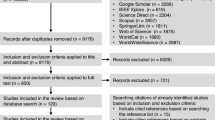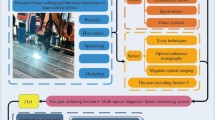Abstract
In any imaging modality the apparent size and shape of the object in the image plane is influenced by the camera parameters and experimental conditions. To extract an accurate measurement of object size from the image, the understanding of the influence of these parameters on the apparent size and shape is important. Lock-in Thermography is one of the advanced imaging Non Destructive Evaluation techniques which is widely used for quantitative defect evaluation and material characterization. The important experimental parameter in Lock-in Thermography is the excitation frequency, which greatly affects both the apparent shape (image definition) and size in resultant phase and amplitude images. Hence, in this study, an attempt is made towards understanding the effect of frequency on the image definition (apparent shape) and defect sizing in Lock-in Thermography through experimental study. Stainless Steel plate with flat bottom holes of various sizes and depths is considered for the experiment. Both phase and amplitude images are considered for analysis. The Canny edge detection technique is implemented for studying the effect of frequency on image definition by extracting the edges of the flat bottom hole. The binary image obtained after edge detection is used for sizing calculation. The apparent shape and size were greatly affected by excitation frequency and depth in both amplitude and phase images. A relation between excitation frequency and depth was established which can be used to predict the excitation frequency where the sizing measurement is accurate.









Similar content being viewed by others
Abbreviations
- µ:
-
Thermal diffusion length
- α:
-
Thermal diffusivity
- f:
-
Excitation frequency
- k:
-
Thermal conductivity
- ρ:
-
Density
- c:
-
Specific heat
- x:
-
Horizontal scanning angle
- y:
-
Vertical scanning angle
- L:
-
Defect depth
- D:
-
Defect size
- P:
-
Pixel resolution
- fr :
-
Frame rate
- G:
-
Gradient vector
- θ:
-
Gradient direction
References
Wetsel GC Jr, McDonald FA (1984) Resolution and definition in photothermal imaging. J Appl Phys 56(11):3081–3085. https://doi.org/10.1063/1.333891
Bai W, Wong BS (2001) Evaluation of defects in composite plates under convective environments using lock-in thermography. Meas Sci Technol 12(2):142. https://doi.org/10.1088/0957-0233/12/2/303
Burgholzer P, Hendorfer G (2013) Limits of spatial resolution for thermography and other non-destructive imaging methods based on diffusion waves. Int J Thermophys 34(8–9):1617–1632. https://doi.org/10.1007/s10765-013-1513-0
Sakagami T, Kubo S (2002) Development of a new non-destructive testing technique for quantitative evaluations of delamination defects in concrete structures based on phase delay measurement using lock-in thermography. Infrared Phys Technol 43(3):311–316. https://doi.org/10.1016/S1350-4495(02)00157-3
Breitenstein O, Langenkamp M, Altmann F, Katzer D, Lindner A, Eggers H (2000) Microscopic lock-in thermography investigation of leakage sites in integrated circuits. Rev Sci Instrum 71(11):4155–4160. https://doi.org/10.1063/1.1310345
Delanthabettu S, Menaka M, Venkatraman B, Raj B (2015) Defect depth quantification using lock-in thermography. Quant Infrared Thermogr J 12(1):37–52. https://doi.org/10.1080/17686733.2015.1013663
Wu D, Wu CY, Busse G (1996) Investigation of resolution in lock-in thermography: theory and experiment. In Proceedings of QIRT 269–274. https://doi.org/10.21611/qirt.1996.044
Ibarra-Castanedo C, Piau JM, Guilbert S, Avdelidis NP, Genest M, Bendada A, Maldague XP (2009) Comparative study of active thermography techniques for the nondestructive evaluation of honeycomb structures. Res Nondestruct Evaluation 20(1):1–31. https://doi.org/10.1080/09349840802366617
Duan Y, Huebner S, Hassler U, Osman A, Ibarra-Castanedo C, Maldague XP (2013) Quantitative evaluation of optical lock-in and pulsed thermography for aluminum foam material. Infrared Phys Technol 60:275–280. https://doi.org/10.1016/j.infrared.2013.05.009
Menner P, Spiessberger C, Gleiter A, Busse G (2010) Aerospace applications of lockin thermography with optical, ultrasonic and inductive excitation. AIP Conf Proc 1211(1):525–532. https://doi.org/10.1063/1.3362439
Zoecke C, Langmeier A, Arnold W (2010) Size retrieval of defects in composite material with lockin thermography. J Phys Conf Ser 214(1):012093. https://doi.org/10.1088/1742-6596/214/1/012093
Zöcke C, Langmeier A, Stöβel R, Arnold W (2009) Reconstruction of the defect shape from lock-in thermography phase images. Quant Infrared Thermogr J 6(1):63–78. https://doi.org/10.3166/qirt.6.63-78
Busse G, Rosencwaig A (1980) Subsurface imaging with photoacoustics. Appl Phys Lett 36:815. https://doi.org/10.1063/1.91327
Inglehart LJ, Grice KR, Favro LD, Kuo PK, Thomas RL (1983) Spatial resolution of thermal wave microscopes. Appl Phys Lett 43(5):446–448. https://doi.org/10.1063/1.94383
Inglehart LJ, Lin MJ, Favro LD, Kuo PK, Thomas R (1983) Spatial resolution of thermal wave microscopes. In 1983 Ultrasonics Symposium. IEEE, pp 668–671. https://doi.org/10.1109/ULTSYM.1983.198141
McDonald FA, Wetsel GC, Clark CG (1983) Effects of frequency on definition and resolution in photothermal imaging of subsurface structure. In 1983 Ultrasonics Symposium. IEEE, pp 672–676. https://doi.org/10.1109/ULTSYM.1983.198142
Choi M, Kang K, Park J, Kim W, Kim K (2008) Quantitative determination of a subsurface defect of reference specimen by lock-in infrared thermography. NDT&E INT 41(2):119–124. https://doi.org/10.1016/j.ndteint.2007.08.006
Junyan L, Qingju T, Xun L, Yang W (2012) Research on the quantitative analysis of subsurface defects for non-destructive testing by lock-in thermography. NDT&E INT 45(1):104–110. https://doi.org/10.1016/j.ndteint.2011.09.002
Ranjit S, Kang K, Kim W (2015) Investigation of lock-in infrared thermography for evaluation of subsurface defects size and depth. Int J Precis Eng Manuf 16(11):2255–2264. https://doi.org/10.1007/s12541-015-0290-z
Busse G, Wu D, Karpen W (1992) Thermal wave imaging with phase sensitive modulated thermography. J Appl Phys 71(8):3962–3965. https://doi.org/10.1063/1.351366
Canny J (1986) A Computational Approach to Edge Detection. IEEE Trans Pattern Anal Mach Intell 8(6):679–698. https://doi.org/10.1109/TPAMI.1986.4767851
Maldague XP, Patrick OM (Ed) Non Destructive Testing Handbook, 3rd Edition, Volume 3, ASNT, USA
Wallbrink C, Wade SA, Jones R (2007) The effect of size on the quantitative estimation of defect depth in steel structures using lock-in thermography. J Appl Phys 101(10):104907. https://doi.org/10.1063/1.2732443
Acknowledgements
The authors are grateful to Dr. A. K. Bhaduri, Director, Indira Gandhi Centre for Atomic Research, Kalpakkam and management of M S Ramaiah Institute of Technology, Bangalore for their constant support and encouragement.
Funding
NA.
Author information
Authors and Affiliations
Corresponding author
Ethics declarations
Conflicts of interest/Competing interests
On behalf of all authors, the corresponding author states that there is no conflict of interest.
Additional information
Publisher's Note
Springer Nature remains neutral with regard to jurisdictional claims in published maps and institutional affiliations.
Appendices
Appendix
Appendix A. Four Pont Correlation Method (FPC)
In a LT experiment, the modulated temperature response of the sample is captured using an IR camera which results in a 3 dimensional image matrix with dimension NHxNVx(Pxfrxn), where NHxNV is the size of image matrix and Pxfrxn is the total number of images captured, where P = 1/f is the period, fr is the frame rate and n is the number of periods. From this 3 D image matrix, one should obtain a 2 D phase and amplitude image matrices. This can be done using Four Point Correlation (FPC) method. In FPC method, initially the response of 1 pixel from 3 D image matrix is considered, which is a 1 D temperature signal. As shown in Fig. 10, all the images in 1 period (N = Pxfr images) of the temperature signal is reduced into 4 equidistant resultant images using the equation (8),
Then the amplitude and phase values for that pixel can be obtained using equations (9) and (10).
This operation is repeated for all the pixels of the image matrix to generate 2 D amplitude and phase images.
Appendix B. Canny Edge Detection Method
First proposed by John Canny in 1986 [21], this method is a multi-stage approach for accurately detecting the edges in an image. The steps involved in Canny edge detection algorithm is given below.
-
Step 1—Smoothing: Any edge is affected by noise present in the image. Hence the first step is to suppress these noise using suitable smoothing filters. Gaussian filters with suitable kernel is most widely used for the convolution of the grayscale image.
-
Step 2 – Computing gradient magnitude and direction: The gradient magnitude (G) of the smoothed image, along x and y directions, is calculated using edge detection operators like Sobel, Prewitt etc. This magnitude tells about the strength of an edge. If Gx and Gy are the gradient vectors along x and y directions, then the gradient magnitude of the smoothed image is calculated using the following formula.
$$G= \sqrt{{G}_{x}^{2}+{G}_{y}^{2}}$$(11)
Then the gradient direction (θ) is calculated which is always perpendicular to the edges using equation (12). The gradient direction value is rounded to 0° (vertical), 45° (diagonal), 90° (horizontal) and 135° (diagonal).
-
Step 3 – Non-maximum suppression: The gradient operation, executed in step 2 results in thick edged image. Non-maximum suppression is an edge-thinning technique, where along the edge, only the edge points with highest intensity values are retained, other points are suppressed.
-
Step 4 – Hysteresis Thresholding: The image resulted from non-maximum suppression will have edges along with spurious lines due to noise. In this step, these noises are eliminated by double thresholding approach. In double thresholding, two threshold values, maximum and minimum, are considered. The edges pixel above maximum threshold value is marked as strong edge pixel and is retained. The edge pixel below minimum threshold value, it is suppressed. Pixel with value between maximum and minimum threshold value is marked as weak edge. This weak edge may be a true edges or may be a noise. If the weak edge is connected to the strong edge, then it is considered as edge. Any weak edges that are not connected to the strong edge are discarded.
Rights and permissions
About this article
Cite this article
Sharath, D., Menaka, M. & Venkatraman, B. Image Definition and Defect Sizing in Lock-in Thermography: An Experimental Investigation. Exp Tech 46, 811–822 (2022). https://doi.org/10.1007/s40799-021-00506-9
Received:
Accepted:
Published:
Issue Date:
DOI: https://doi.org/10.1007/s40799-021-00506-9





